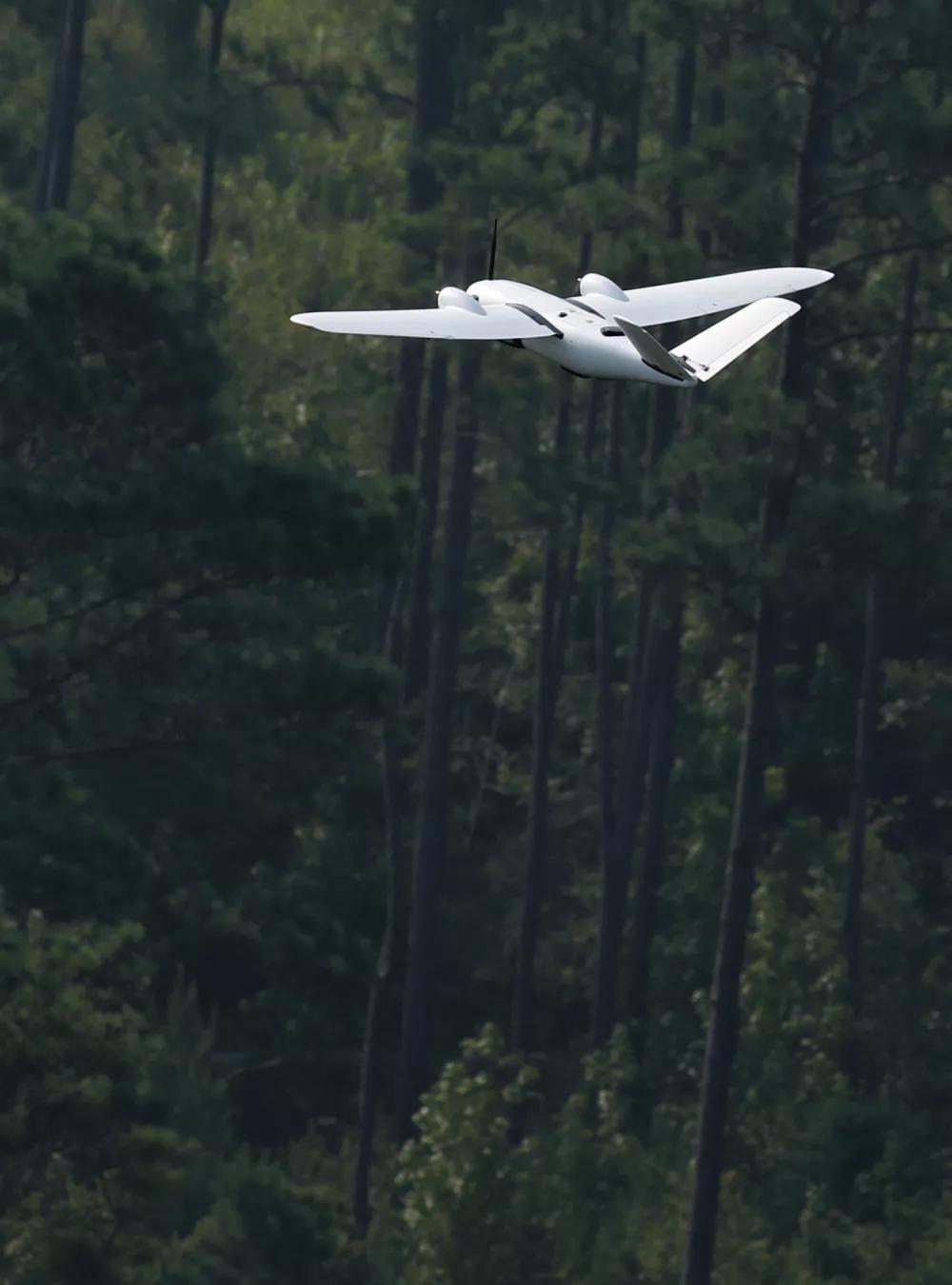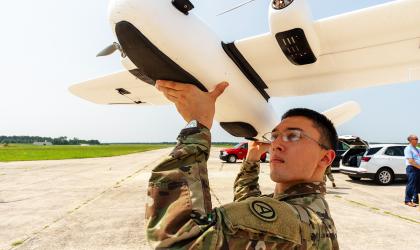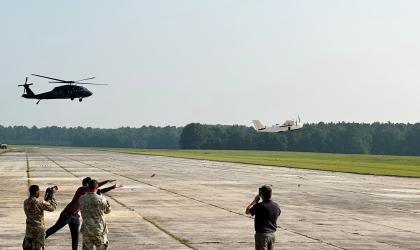Small, slow, and flying under radar, uncrewed aircraft can elude traditional detection systems. MITRE developed an early warning system that employs the world’s best sensors—human eyes and brains.

As Drones Become Weapons of Choice, a Back-to-Basics Way to Counter Them

A small, white, uncrewed aircraft hand-launched from a patch of tarmac follows a preplanned, low-altitude route and overflies a military facility. Does it carry sensors? Cameras? Explosives?
The potential threat posed by uncrewed aerial systems (UAS) came into focus in 2019, when drones attacked Saudi Aramco oil facilities in Saudi Arabia. People on the ground saw the incoming drones but didn’t know how to report them.
Fast forward to 2023, and MITRE has delivered a solution. We developed the Counter-UAS Alerting, Reporting, and Processing Engine for CARPE Dronvm at the request of U.S. Air Forces Central (AFCENT)—providing a much needed early-detection and warning capability. We also demonstrated this technology for U.S. Army Central (ARCENT) during an experiment in South Carolina this summer.
Drones: Changing the Face of Conflict
MITRE brings years of experience developing UAS and counter-UAS capability. UASs, commonly known as drones, have been successfully used against targets around the globe. Today, both Ukraine and Russia are targets of drone attacks, as Russia’s attempt to conquer its democratic neighbor has faltered.
At particular risk: U.S. and partner-nation facilities in the Middle East, as drones increasingly become a weapon of choice for adversaries in the region.
The drone-defense challenge compounds as the threat proliferates. With relatively inexpensive technology needed to create these weapons, bad actors across the world are all too willing to distribute the systems. And many drones are small, slow, and fly at low-altitude—making them hard to spot and difficult to shoot down.
We pair technology with the best sensors, the human eyes and brains, to enable a counter-drone strategy.
From MITRE R&D Proposal to Reality
The CARPE Dronvm (Seize the Drone) technology originated from a 2017 MITRE independent research and development proposal. But it wouldn’t be until the 2019 drone attacks in Saudi Arabia that the Air Force approved a requirement and asked us to deliver the capability.
MITRE's Greg Tavarez, Shaw Air Force Base site and CARPE Dronvm innovation lead, says he's excited for our work as it “pairs state-of-the art technology with the best sensors, the human eyes and brains, to quickly and efficiently enable a counter-drone strategy wherever it's needed.”
The July 18 ARCENT experiment saw MITRE and Defense Department personnel stationed along a more than 30-mile UAS flight path. Participants were asked to spot the UAS and, using the CARPE Dronvm app, capture an image of the drone with their smart phones.
CARPE Dronvm then alerted its users of the UAS’s presence, in real time, and warned observers to take shelter if they felt threatened. The drone was tailed by a Blackhawk helicopter staffed by Army and MITRE personnel, while AFCENT airmen and MITRE staff monitored the reports from a command post using CARPE Dronvm’s situational awareness map.
Countering drones in the U.S. Central Command (USCENTCOM) area of operations “is essential to keeping our personnel, aircraft, and equipment safe,” said Air Force Lt. Col. Steven Norris, AFCENT counter-UAS cell chief. “With CARPE Dronvm, every single warfighter can help sense and warn, creating a comprehensive layered defense that will tie into our existing command and control architecture and increase awareness of threats.”
An Enterprise Approach to UAS Technology

CARPE Dronvm is just one in a long line of MITRE-led UAS developments working toward whole-of-nation integrated solutions.
In August, we opened an advanced drone testing and evaluation facility in Orange, Va., between our Charlottesville and Quantico sites. The facility serves as a proving ground for staff and government partners developing, testing, and evaluating drones and counter-UAS systems.
MITRE’s Engenuity subsidiary has a Safely Operating Aircraft Remotely (SOAR™) training program near the former Griffiss Air Force Base in Central New York. It's available to public-safety drone operators to help address inconsistent remote pilot training standards and improve operations in time-sensitive, dangerous, and high-risk situations.
And CARPE Dronvm itself has clear homeland defense applications. It can be used to help secure large gatherings such as concerts and sporting events, by linking UAS observations to law enforcement or security personnel. For DoD, effective drone situational awareness and defenses will be key to defending the homeland, securing U.S. military installations, and protecting partners and allies overseas.
The experiment, or proof of principle, was “a huge success,” said Army Maj. Travis Valley, ARCENT Task Force 39 operations officer. In a real-world scenario, CARPE Dronvm would alert command-center personnel, security forces, and other app users to a drone’s presence and track the threat—allowing a faster, more effective response.
“We expanded the experiment footprint, covering 50 kilometers…to prove the CARPE Dronvm app works,” Valley noted. “It did; in fact, it exceeded my expectations on the simplicity of use and the program’s drone detection ability.”
Moving from Experimentation to Deployment
Lt. Gen. Patrick Frank, ARCENT commanding general, notes the UAS threat represents a shared security challenge for the U.S. and its regional partners as AFCENT and ARCENT oversee their service’s operations in the USCENTCOM area of responsibility.
To address this challenge, USCENTCOM seeks to validate and deploy the CARPE Dronvm capability at bases throughout the Middle East. Later this fall, a MITRE team will deploy to the region for additional validation experiments in a partner nation.
Join our community of innovators, learners, knowledge-sharers, and risk takers. View our Job Openings.